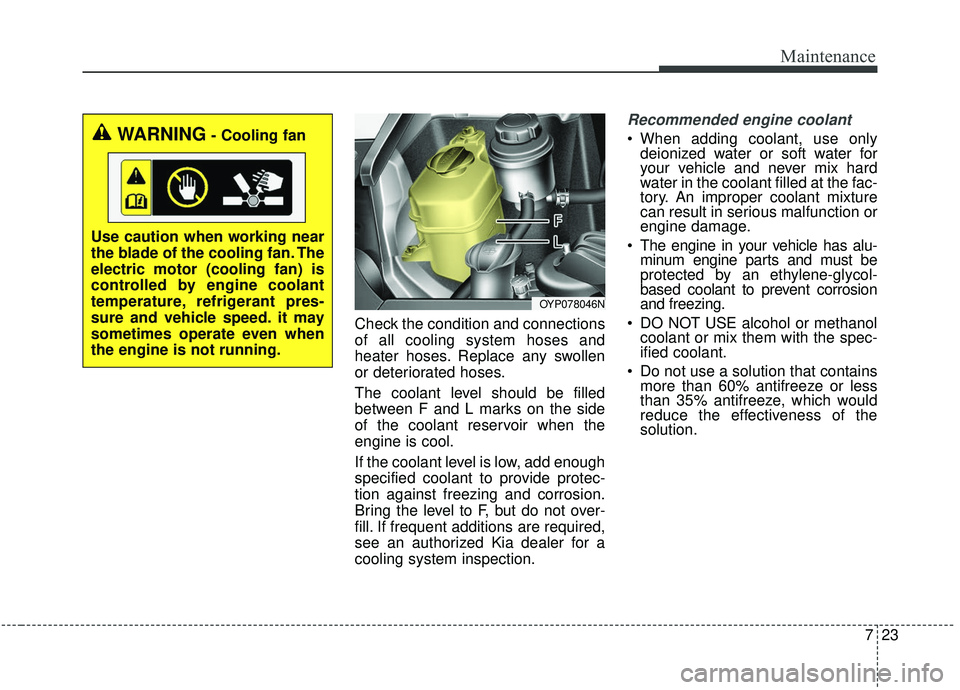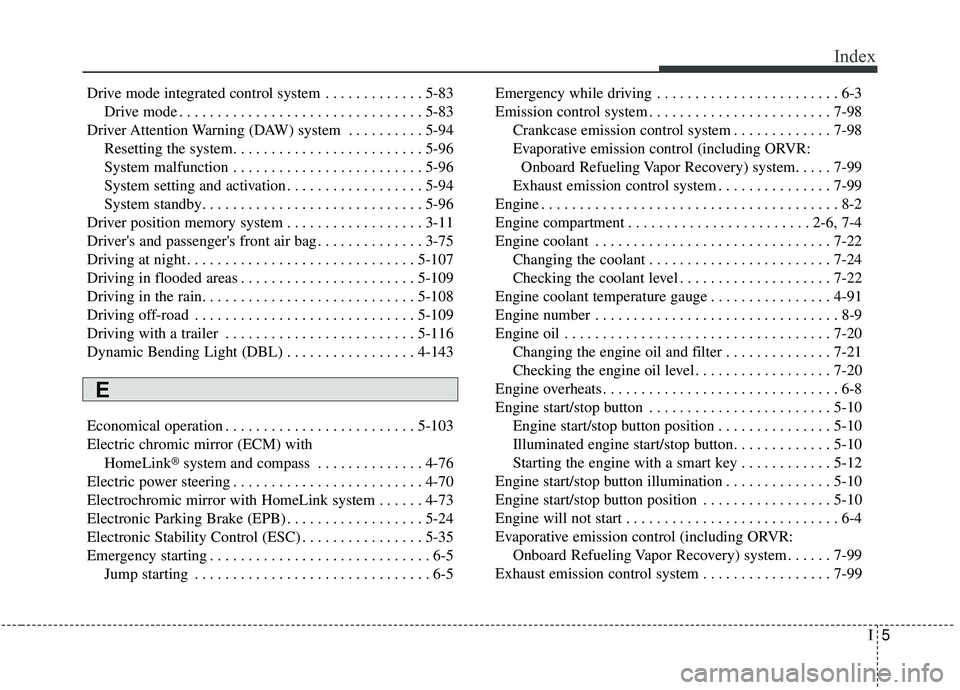Page 490 of 593

723
Maintenance
Check the condition and connections
of all cooling system hoses and
heater hoses. Replace any swollen
or deteriorated hoses.
The coolant level should be filled
between F and L marks on the side
of the coolant reservoir when the
engine is cool.
If the coolant level is low, add enough
specified coolant to provide protec-
tion against freezing and corrosion.
Bring the level to F, but do not over-
fill. If frequent additions are required,
see an authorized Kia dealer for a
cooling system inspection.
Recommended engine coolant
When adding coolant, use onlydeionized water or soft water for
your vehicle and never mix hard
water in the coolant filled at the fac-
tory. An improper coolant mixture
can result in serious malfunction or
engine damage.
The engine in your vehicle has alu- minum engine parts and must be
protected by an ethylene-glycol-
based coolant to prevent corrosion
and freezing.
DO NOT USE alcohol or methanol coolant or mix them with the spec-
ified coolant.
Do not use a solution that contains more than 60% antifreeze or less
than 35% antifreeze, which would
reduce the effectiveness of the
solution.
OYP078046N
WARNING- Cooling fan
Use caution when working near
the blade of the cooling fan. The
electric motor (cooling fan) is
controlled by engine coolant
temperature, refrigerant pres-
sure and vehicle speed. it may
sometimes operate even when
the engine is not running.
Page 491 of 593
Maintenance
24
7
For mixture percentage, refer to the
following table.Changing the coolant
Have the coolant changed by an
authorized Kia dealer according to
the Maintenance Schedule at the
beginning of this chapter.
Put a thick cloth around the radiator
cap before refilling the coolant in
order to prevent the coolant from
overflowing into engine parts such as
the alternator.
OYP074066N
Ambient
Temperature Mixture Percentage
(volume)
Antifreeze Water
-15°C (5°F)35 65
-25°C (-13°F)4060
-35°C (-31°F)5050
-45°C (-49°F)6040
WARNING
Radiator cap
Do not remove the radiator cap
when the engine and radiator
are hot. Scalding hot coolant
and steam may blow out under
pressure which may result in
serious injury.
Page 566 of 593

799
Maintenance
2. Evaporative emission con-trol (including ORVR:
Onboard Refueling Vapor
Recovery) system
The Evaporative Emission Control
System is designed to prevent fuel
vapors from escaping into the atmos-
phere.
(The ORVR system is designed to
allow the vapors from the fuel tank to
be loaded into a canister while refu-
eling at the gas station, preventing
the escape of fuel vapors into the
atmosphere.)
Canister
Fuel vapors generated inside the fuel
tank are absorbed and stored in the
onboard canister. When the engine is
running, the fuel vapors absorbed in
the canister are drawn into the surge
tank through the purge control sole-
noid valve.
Purge Control Solenoid Valve(PCSV)
The purge control solenoid valve is
controlled by the Engine Control
Module (ECM); when the engine
coolant temperature is low during
idling, the PCSV closes so that evap-
orated fuel is not taken into the
engine. After the engine warms up
during ordinary driving, the PCSV
opens to introduce evaporated fuel to
the engine.
3. Exhaust emission control
system
The Exhaust Emission Control System
is a highly effective system which con-
trols exhaust emissions while main-
taining good vehicle performance.
Vehicle modifications
This vehicle should not be modified.
Modification of your vehicle could
affect its performance, safety or dura-
bility and may even violate governmen-
tal safety and emissions regulations.
In addition, damage or performance
problems resulting from any modifi-
cation may not be covered under
warranty.
If you use unauthorized electronic
devices, it may cause the vehicle to
operate abnormally, wire damage,
battery discharge and fire. For your
safety, do not use unauthorized
electronic devices.
Page 582 of 593

I5
Index
Drive mode integrated control system . . . . . . . . . . . . . 5-83Drive mode . . . . . . . . . . . . . . . . . . . . . . . . . . . . . . . . 5-83
Driver Attention Warning (DAW) system . . . . . . . . . . 5-94 Resetting the system. . . . . . . . . . . . . . . . . . . . . . . . . 5-96
System malfunction . . . . . . . . . . . . . . . . . . . . . . . . . 5-96
System setting and activation . . . . . . . . . . . . . . . . . . 5-94
System standby. . . . . . . . . . . . . . . . . . . . . . . . . . . . . 5-96
Driver position memory system . . . . . . . . . . . . . . . . . . 3-11
Driver's and passenger's front air bag . . . . . . . . . . . . . . 3-75
Driving at night . . . . . . . . . . . . . . . . . . . . . . . . . . . . . . 5-107
Driving in flooded areas . . . . . . . . . . . . . . . . . . . . . . . 5-109
Driving in the rain. . . . . . . . . . . . . . . . . . . . . . . . . . . . 5-108
Driving off-road . . . . . . . . . . . . . . . . . . . . . . . . . . . . . 5-109
Driving with a trailer . . . . . . . . . . . . . . . . . . . . . . . . . 5-116
Dynamic Bending Light (DBL) . . . . . . . . . . . . . . . . . 4-143
Economical operation . . . . . . . . . . . . . . . . . . . . . . . . . 5-103
Electric chromic mirror (ECM) with
HomeLink
®system and compass . . . . . . . . . . . . . . 4-76
Electric power steering . . . . . . . . . . . . . . . . . . . . . . . . . 4-70
Electrochromic mirror with HomeLink system . . . . . . 4-73
Electronic Parking Brake (EPB) . . . . . . . . . . . . . . . . . . 5-24
Electronic Stability Control (ESC) . . . . . . . . . . . . . . . . 5-35
Emergency starting . . . . . . . . . . . . . . . . . . . . . . . . . . . . . 6-5 Jump starting . . . . . . . . . . . . . . . . . . . . . . . . . . . . . . . 6-5 Emergency while driving . . . . . . . . . . . . . . . . . . . . . . . . 6-3
Emission control system . . . . . . . . . . . . . . . . . . . . . . . . 7-98
Crankcase emission control system . . . . . . . . . . . . . 7-98
Evaporative emission control (including ORVR:Onboard Refueling Vapor Recovery) system. . . . . 7-99
Exhaust emission control system . . . . . . . . . . . . . . . 7-99
Engine . . . . . . . . . . . . . . . . . . . . . . . . . . . . . . . . . . . . \
. . . 8-2
Engine compartment . . . . . . . . . . . . . . . . . . . . . . . . 2-6, 7-4
Engine coolant . . . . . . . . . . . . . . . . . . . . . . . . . . . . . . . 7-22 Changing the coolant . . . . . . . . . . . . . . . . . . . . . . . . 7-24
Checking the coolant level . . . . . . . . . . . . . . . . . . . . 7-22
Engine coolant temperature gauge . . . . . . . . . . . . . . . . 4-91
Engine number . . . . . . . . . . . . . . . . . . . . . . . . . . . . . . . . 8-9
Engine oil . . . . . . . . . . . . . . . . . . . . . . . . . . . . . . . . . . . 7-\
20 Changing the engine oil and filter . . . . . . . . . . . . . . 7-21
Checking the engine oil level . . . . . . . . . . . . . . . . . . 7-20
Engine overheats . . . . . . . . . . . . . . . . . . . . . . . . . . . . . . . 6-8
Engine start/stop button . . . . . . . . . . . . . . . . . . . . . . . . 5-10 Engine start/stop button position . . . . . . . . . . . . . . . 5-10
Illuminated engine start/stop button. . . . . . . . . . . . . 5-10
Starting the engine with a smart key . . . . . . . . . . . . 5-12
Engine start/stop button illumination . . . . . . . . . . . . . . 5-10
Engine start/stop button position . . . . . . . . . . . . . . . . . 5-10
Engine will not start . . . . . . . . . . . . . . . . . . . . . . . . . . . . 6-4
Evaporative emission control (including ORVR: Onboard Refueling Vapor Recovery) system . . . . . . 7-99
Exhaust emission control system . . . . . . . . . . . . . . . . . 7-99
E